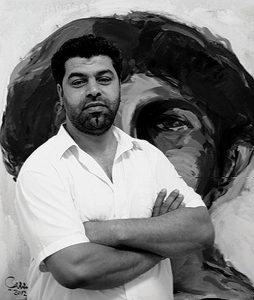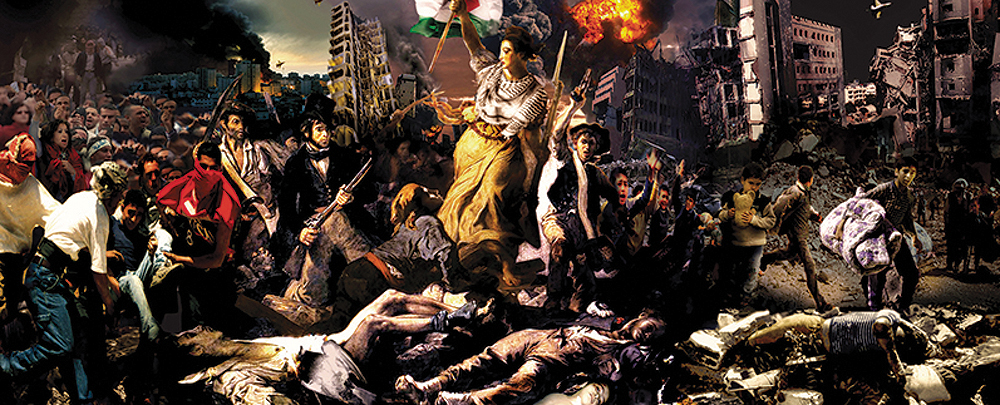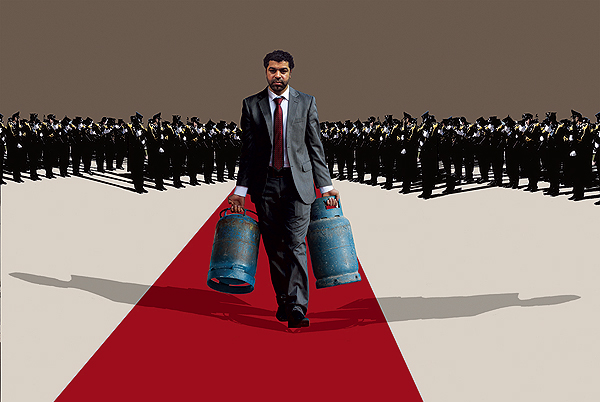 The artist Mohammed Al Hawajri was born in Bureij Refugee Camp in Gaza in 1976. His passion is contemporary art. A student of Professor Marwan Qassab Bashi, he participated in 1999, 2000, and 2001 in the International Summer Academy held by the Khalid Shoman Foundation at Darat al Funun in Amman, Jordan. In 2000, he won first prize at the closing exhibition of this academy. He received a grant that allowed him to spend 2008–2009 in Paris at the Cité Internationale des Arts. Al Hawajri’s works have been on display in many exhibitions in Palestine and abroad, and he has received invitations to participate in exhibitions in Britain, Italy, Austria, France, Switzerland, the United States, Argentina, Japan, Jordan, Dubai, Abu Dhabi, Bahrain, Qatar, Egypt, and Lebanon.
The artist Mohammed Al Hawajri was born in Bureij Refugee Camp in Gaza in 1976. His passion is contemporary art. A student of Professor Marwan Qassab Bashi, he participated in 1999, 2000, and 2001 in the International Summer Academy held by the Khalid Shoman Foundation at Darat al Funun in Amman, Jordan. In 2000, he won first prize at the closing exhibition of this academy. He received a grant that allowed him to spend 2008–2009 in Paris at the Cité Internationale des Arts. Al Hawajri’s works have been on display in many exhibitions in Palestine and abroad, and he has received invitations to participate in exhibitions in Britain, Italy, Austria, France, Switzerland, the United States, Argentina, Japan, Jordan, Dubai, Abu Dhabi, Bahrain, Qatar, Egypt, and Lebanon.
The first of Al Hawajri’s many personal exhibitions, “New Faces” (1999), was held at the French Cultural Center in Gaza and featured a new technique applied to images of French actress Catherine Deneuve. “Bones” (2000, supported by the A.M. Qattan Foundation, Ramallah) explored the themes of death and separation.
Whereas Al Hawajri early in his career tried to separate his art from politics, his approach changed in the wake of the Israeli attack in 2008–2009. He explains, “My innermost feelings deeply affected my artwork and express my repulsion to that ugly attack. Ironically, this took place while I was in exile in Paris.” “M43” (2010) features 43 drawings of a soldier in various settings, the letter M stands for the weapons used by Israeli soldiers. Done with ridicule, these works contain a sense of black comedy that has become typical in much of the artist’s recent work.
“Cactus Borders” (2010) commented on the difficult situation in Gaza under siege. Viewers’ initial impressions of humor change when they let themselves be drawn into the depths of the work where they find hardship and agonies. “Cactus Borders,” which was funded by the Arab Fund for Arts and Culture, featured sculptures made of wood and nails that compare the lives of contemporary Palestinians in Gaza to the spiky succulents, also touching on the traditional ways that Palestinian farmers delineate property boundaries.
“Animal Farm” (2011), supported by the French Consulate General in Jerusalem, featured large paintings in strong, frequently surrealistic colors that lean towards abstraction of animal shapes that were inspired by the artist’s memories of times spent with his grandmother who raised animals. Here, paradox and harmony overlap between the different feelings of joy and sorrow, stillness and rowdiness, suppression and the freedom to further coexist, portraying a revolutionary peace.
In “Guernica” (2013), supported by the Danish Centre for Culture and Development in Palestine, Al Hawajri represented paintings by Picasso, Dali, Van Gogh, Chagall, and others, superimposing via Photoshop photographs of contemporary Gaza’s environment and recent violent events to explore the condition of war and anxiety.
In 2014, Al Hawajri produced a series of artwork that combined performance, photography, and video, in which he laid out a red carpet in various locations throughout Gaza in biting criticism of the attention which the media showers on celebrities.
Al Hawajri has participated in numerous group exhibitions, both locally and abroad. Most important among them were “Palestine: Creativity in All Its Stages” (2009–2010), which was held at the Arab World Institute in Paris before it was moved to the National Museum in Bahrain.
In 2002, he was a founding member of the ELTIQA Group for Contemporary Art.



